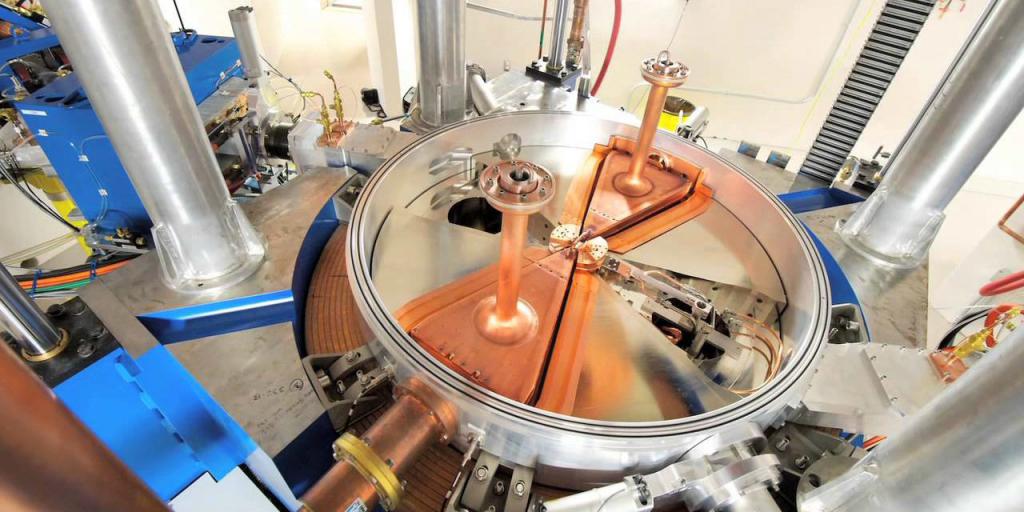The cyclotron is an accelerator of heavy particles (ions and protons). He accelerates them along a spiral path. Particles are held by a spiral trajectory by a static magnetic field and are accelerated by a rapidly changing (radio frequency) electric field. Ernest O. Lawrence was awarded the 1939 Nobel Prize in Physics for this invention.
Benefits
Cyclotrons were the most powerful particle accelerator technology until the 1950s, when they were replaced by a synchrotron. They are still used to create particle beams in physics and nuclear medicine. The largest single-engine cyclotron was a 4.67 m (184 in) synchrocyclotron, built in 1940-1946 by Lawrence at the University of California at Berkeley. The device could accelerate protons to 730 million electron-volts (MeV). The largest cyclotron is the TRIUMF 17.1 m (56 ft) multimagnetic accelerator at the University of British Columbia in Vancouver, which can produce 500 MeV protons.
More than 1200 cyclotrons are used in nuclear medicine worldwide for the production of radionuclides.
History
The first cyclotron was developed and patented by Ernest Lawrence in 1932 at the University of California at Berkeley. He used large electromagnets recycled from obsolete Poulsen arc radio transmitters provided by the Federal Telegraph Company. A graduate student, M. Stanley Livingston, did most of the work of transforming a concept divorced from reality into a real working mechanism. Lawrence read an article on the linac drift tube concept from Rolf Widerøe, which also worked similarly with the betatron concept.
Lawrence built a series of cyclotrons at the University of California's Berkeley Radiation Laboratory, which at that time were the most powerful accelerators in the world: a 69 cm (27 inch) 4.8 MeV machine (1932), a 94 cm (37 inch) diameter machine 8 MeV (1937) and a machine 16 cm (16 inches) wide (1939). He also developed the 467 cm (184 in) synchronizer (1945). Lawrence received the Nobel Prize in physics for this work in 1939. The cyclotron is one of the very first charged particle accelerators.

The first European cyclotron was assembled in Leningrad at the physics department of the Radium Institute, led by Vitaly Khlopin. This Leningrad apparatus was first introduced in 1932 by George Gamow and Lev Mysovsky, it was put into operation in 1937. In the cyclotron, electric and magnetic acceleration was always used uniformly, therefore, in the construction of this particle accelerator, an electrified magnet was always used. In Nazi Germany, in Heidelberg, a cyclotron was built under the supervision of Walter Bothe and Wolfgang Gentner with the support of Hereswaffenhamt. It has been operating since 1943.
Principle of operation
This device accelerates beams of photons and charged particles up to the speed of light, rotating them along a spiral-shaped space inside the accelerator. Thanks to him, it was discovered that during rotation with great speed, the mass of particles changes, as a rule, in the direction of increase. The cyclotron is a real storehouse of such discoveries. A relativistic increase in the mass of particles in a photon beam usually requires either a change in the magnetic field inside the accelerator (the so-called isochronous cyclotron) or a modification of its frequency (synchronous cyclotron). Due to its unique principle of operation, this mechanism has become the prototype of other similar accelerators such as the Large Hadron Collider.
Application and research methods
The fact is that due to its ability to accelerate charged particles, this mechanism is used to produce various isotopes. Isotopes are a thing necessary in modern technical means, because the use of the cyclotron is not limited only to experimental physics. For example, it is used in medicine to produce radioisotopes such as technetium-99.
Modification
The cyclotron was improved compared to the linear accelerators that were available when it was invented, being more economical and spatial, due to the repeated interaction of particles with an accelerating field. In the 1920s, it was impossible to create high-power high-frequency radio waves, which are used in modern linear accelerators (generated by klystrons). Thus, for particles with higher energy, insignificant long linear structures were required. The compactness of the cyclotron also reduces other costs, such as foundations, radiation protection, and a building block. Cyclotrons have one electric driver, which saves both money and power. In addition, cyclotrons are capable of forming a continuous stream of particles on the target; therefore, the average power transmitted from the particle beam to the target is relatively large.
What is the trajectory of motion in the cyclotron?
The spiral path of the cyclotron beam can only “synchronize” with voltage sources of the klystron type (constant frequency), if the accelerated particles are approximately subject to Newton’s laws of motion. If the particles become fast enough that the relativistic effects become important, the beam becomes out of phase with the vibrational electric field and cannot receive any additional acceleration. Therefore, the classical cyclotron can only accelerate particles up to several percent of the speed of light. This is the period of revolution of a charged particle in a cyclotron. To accommodate the increased mass, the magnetic field can be changed by correctly forming the pole pieces, as in isochronous cyclotrons operating in a pulsed mode and changing the frequency applied to cases, as in synchrocyclotrons. Either of which is limited by the decrease in the economic efficiency of creating large machines.
Cost limits have been overcome by using more sophisticated klystron-based linear or accelerators based on klystrons, which have the advantage of scalability, offering more power in an improved cost structure as machines grow larger. The calculations themselves are made by comparing the power of collision of particles with each other, which in turn depends on what is the trajectory of the charged particle in the cyclotron.